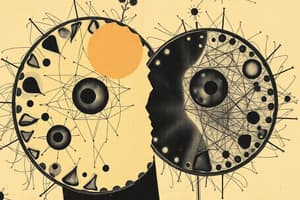Podcast
Questions and Answers
What happens to the nucleolus during early prophase?
What happens to the nucleolus during early prophase?
- It disappears (correct)
- It forms new ribosomes
- It breaks down into nucleosomes
- It starts to duplicate
Which structure is responsible for organizing chromosomes during mitosis?
Which structure is responsible for organizing chromosomes during mitosis?
- Nuclear envelope
- Cytoplasmic membrane
- Nucleolus
- Mitotic spindle (correct)
What role do kinetochores play during prometaphase?
What role do kinetochores play during prometaphase?
- They assist in separating sister chromatids (correct)
- They hold sister chromatids together
- They break down the nuclear envelope
- They connect microtubules to the cell poles
During which phase of mitosis do sister chromatids separate and move to opposite poles?
During which phase of mitosis do sister chromatids separate and move to opposite poles?
What structural change occurs to the nuclear envelope during the prometaphase?
What structural change occurs to the nuclear envelope during the prometaphase?
What event occurs during the telophase stage of mitosis?
What event occurs during the telophase stage of mitosis?
Which structure is responsible for separating daughter chromosomes during mitosis?
Which structure is responsible for separating daughter chromosomes during mitosis?
What is the primary function of cytokinesis?
What is the primary function of cytokinesis?
What happens to the mitotic spindle during telophase?
What happens to the mitotic spindle during telophase?
How does the nuclear envelope behave during the completion of mitosis?
How does the nuclear envelope behave during the completion of mitosis?
Flashcards are hidden until you start studying
Study Notes
Prophase
- Early prophase involves structural breakdown and preparation for chromosome division.
- Duplicated chromosomes condense into compact, tightly wound forms.
- The nuclear envelope begins to disintegrate, signaling nuclear breakdown.
- A mitotic spindle forms from microtubules, extending from the edges of the dividing cell.
- The spindle organizes and mobilizes chromosomes during mitosis.
- The nucleolus, where ribosomes and rRNA are produced, disappears.
Prometaphase
- Occurs at the transition from prophase to metaphase.
- Nuclear envelope completely breaks down.
- Microtubules extend from cell poles to the equator, connecting with kinetochores.
- Kinetochores are disc-shaped protein complexes at the centromere, crucial for chromosome movement.
- Kinetochore fibers facilitate the migration of chromosomes towards the cell center.
Metaphase
- Chromosomes align along the metaphase plate, formed by equal tension from polar fibers.
- The metaphase plate is a conceptual plane, not a physical structure.
Anaphase
- Sister chromatids are separated and pulled to opposite poles as "glue" proteins degrade.
- Each separated chromatid becomes a distinct daughter chromosome.
- Microtubules shorten, enabling the cell to elongate and prepare for division.
- Cylinder-shaped kinetochore fibers shorten as chromosomes migrate towards poles.
- Upon completion, poles contain identical sets of chromosomes, initiating cytokinesis.
Telophase
- Final stage of mitosis when nuclear envelopes reform around divided chromatids.
- Nuclei form at opposite poles, and mitotic spindle disassembles.
- Chromatin fibers unwind into a loose form, and nucleoli reappear.
- After telophase, mitosis concludes as genetic material is distributed into two cells.
Cytokinesis
- The process of cytoplasmic division occurs to create two genetically identical daughter cells.
- Each daughter cell has its own nucleus and complete DNA copy.
- Begins before anaphase completes and finishes shortly after telophase.
- In animal cells, actin and myosin proteins form a ring, pinching the cell into two.
Cell Cycle
- The cell cycle encompasses a series of events for DNA duplication and cell division, essential for reproduction in living organisms.
- Alternates between interphase and cell division, crucial for cellular turnover in tissues.
- Cell cycle duration varies by cell type; early frog embryos divide every 30 minutes, while mammalian fibroblasts divide roughly once per day.
Interphase
- Spans between successive cell divisions, including the G0 phase for non-dividing cells.
- Consists of three phases: G1 (cell growth and organelle doubling), S (DNA replication), and G2 (preparation for mitosis).
- G1 phase includes RNA and protein synthesis, while S phase focuses on DNA synthesis. G2 prepares the cell for ensuing M phase.
M Phase
- Represents the actual division phase, involving mitosis followed by cytokinesis for complete cell division.
Studying That Suits You
Use AI to generate personalized quizzes and flashcards to suit your learning preferences.




